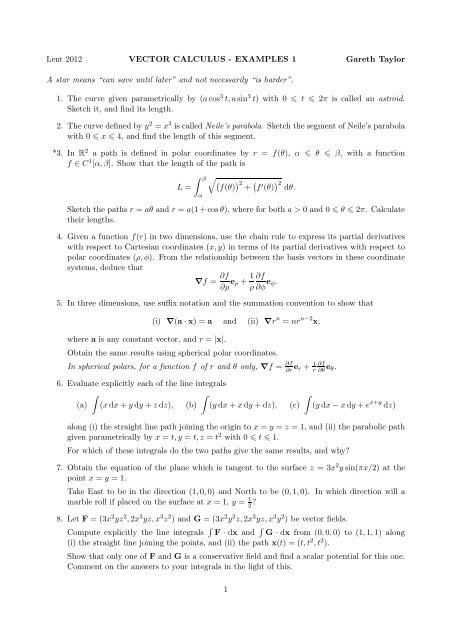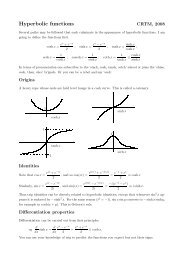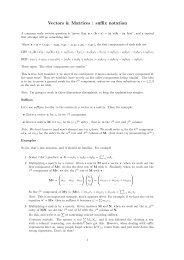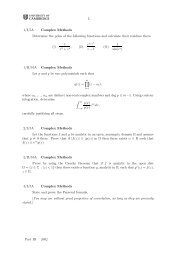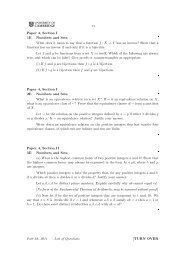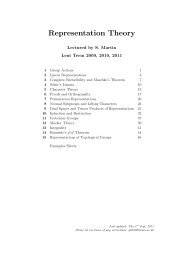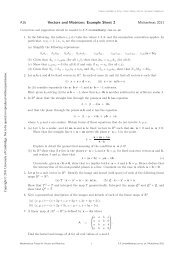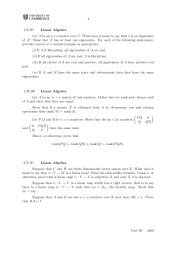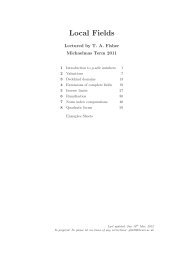Lent 2012 VECTOR CALCULUS - EXAMPLES 1 Gareth ... - Tartarus
Lent 2012 VECTOR CALCULUS - EXAMPLES 1 Gareth ... - Tartarus
Lent 2012 VECTOR CALCULUS - EXAMPLES 1 Gareth ... - Tartarus
You also want an ePaper? Increase the reach of your titles
YUMPU automatically turns print PDFs into web optimized ePapers that Google loves.
<strong>Lent</strong> <strong>2012</strong> <strong>VECTOR</strong> <strong>CALCULUS</strong> - <strong>EXAMPLES</strong> 1 <strong>Gareth</strong> TaylorA star means “can save until later” and not necessarily “is harder”.1. The curve given parametrically by (acos 3 t,asin 3 t) with 0 t 2π is called an astroid.Sketch it, and find its length.2. The curve defined by y 2 = x 3 is called Neile’s parabola. Sketch the segment of Neile’s parabolawith 0 x 4, and find the length of this segment.*3. In R 2 a path is defined in polar coordinates by r = f(θ), α θ β, with a functionf ∈ C 1 [α,β]. Show that the length of the path isL =∫ βα√ (f(θ) ) 2 +(f ′ (θ) ) 2 dθ.Sketch the paths r = aθ and r = a(1+cos θ), where for both a > 0 and 0 θ 2π. Calculatetheir lengths.4. Given a function f(r) in two dimensions, use the chain rule to express its partial derivativeswith respect to Cartesian coordinates (x,y) in terms of its partial derivatives with respect topolar coordinates (ρ,φ). From the relationship between the basis vectors in these coordinatesystems, deduce that∇f = ∂f∂ρ e ρ + 1 ∂fρ ∂φ e φ.5. In three dimensions, use suffix notation and the summation convention to show thatwhere a is any constant vector, and r = |x|.(i) ∇(a · x) = a and (ii) ∇r n = nr n−2 x,Obtain the same results using spherical polar coordinates.In spherical polars, for a function f of r and θ only, ∇f = ∂f∂r e r + 1 ∂fr ∂θ e θ.6. Evaluate explicitly each of the line integrals∫∫∫(a) (xdx + y dy + z dz), (b) (y dx + xdy + dz), (c) (y dx − xdy + e x+y dz)along (i) the straight line path joining the origin to x = y = z = 1, and (ii) the parabolic pathgiven parametrically by x = t,y = t,z = t 2 with 0 t 1.For which of these integrals do the two paths give the same results, and why?7. Obtain the equation of the plane which is tangent to the surface z = 3x 2 y sin(πx/2) at thepoint x = y = 1.Take East to be in the direction (1,0,0) and North to be (0,1,0). In which direction will amarble roll if placed on the surface at x = 1, y = 1 2 ?8. Let F = (3x 2 yz 2 ,2x 3 yz,x 3 z 2 ) and G = (3x 2 y 2 z,2x 3 yz,x 3 y 2 ) be vector fields.Compute explicitly the line integrals ∫ F · dx and ∫ G · dx from (0,0,0) to (1,1,1) along(i) the straight line joining the points, and (ii) the path x(t) = (t,t 2 ,t 2 ).Show that only one of F and G is a conservative field and find a scalar potential for this one.Comment on the answers to your integrals in the light of this.1
9. A curve C is given parametrically in Cartesian coordinates byx(t) = ( cos(sin nt)cos t, cos(sin nt)sin t, sin(sin nt) ) , 0 t 2π,where n is some fixed integer.Using spherical polar coordinates, sketch and describe C. Show that ∫ ()CF · dx = 2π, whereF(x) = −y and C is traversed in the direction of increasing t.x 2 +y 2 ,xx 2 +y 2 ,0Show also that F is the gradient of a scalar. Comment on your results.10. Use the substitution x = r cos θ, y = 1 2r sinθ to evaluate∫x 2x 2 + 4y 2 dA,where A is the region between the two ellipses x 2 + 4y 2 = 1, x 2 + 4y 2 = 4.A11. The closed curve C in the (x,y) plane consists of the arc of the parabola y 2 = 4ax (a > 0)between the points (a, ±2a) and the straight line joining (a, ∓2a). The area enclosed by C isA. By calculating the integrals explicitly, show that∫∫(x 2 y dx + xy 2 dy) = (y 2 − x 2 )dA = 104105 a4 ,where C is described anticlockwise.C12. The region A is bounded by the line segments {x = 0, 0 y 1}, {y = 0, 0 x 1}, {y = 1,0 x 3 4 }, and by an arc of the parabola y2 = 4(1 − x). Consider a mapping into the (x,y)plane from the (u,v) plane defined by the transformation x = u 2 − v 2 , y = 2uv. Sketch A andalso the two regions in the (u,v) plane which are mapped into it. Hence calculate∫dA(x 2 + y 2 ) 1/2.*13. Without changing the order of integration, show that∫ 1[∫ 1]x − y(x + y) 3 dy dx = 1 ∫ 1[∫ 1]2 , and x − y(x + y) 3 dx dy = − 1 2 .0Comment on these results.0A14. Let T be the tetrahedron with vertices at (0,0,0), (1,0,0), (0,1,0) and (0,0,1). Find thevolume V of T, and hence find the centre of volume, given by∫1xdV .VT15. A solid cone is bounded by the surface θ = α (in spherical polar coordinates) and the surfacez = a. Its mass density is ρ 0 cos θ. Show that its mass is 2π 3 ρ 0a 3 (sec α − 1).16. [Tripos, 2005/III/12]Express the integralI =∫ ∞0dx∫ 10dy∫ x0A00dz xe −Ax/y−Bxy−Cyzin terms of the new variables α = x/y, β = xy, γ = yz. Hence show thatI =Assume that A, B and C are positive.12A(A + B)(A + B + C) .2
<strong>Lent</strong> <strong>2012</strong> <strong>VECTOR</strong> <strong>CALCULUS</strong> - <strong>EXAMPLES</strong> 2 <strong>Gareth</strong> Taylor1. A circular helix is given by x = (acos t,asin t,ct). Calculate the tangent t, principal normaln, curvature κ, binormal b, and torsion τ. Sketch the helix for a,c > 0, showing t, n, b atsome point on the helix.*2. Explain why the tangent, principal normal and binormal form an orthonormal system.Show that the torsion can be written asτ = 1 [κ 2 t, ∂t ]∂s , ∂2 t∂s 2 ,where [a,b,c] denotes the scalar triple product a · b × c.Verify this identity for the helix in question 1.3. *(a) Show that a curve in the plane given by x(t) = (x(t),y(t)) has curvatureκ =|ẋÿ − ẍẏ|(ẋ 2 + ẏ 2 ) 3/2.(b) Find the minimum and maximum curvature of the ellipse x 2 /a 2 + y 2 /b 2 = 1. Commenton the case when a = b.If you have done (a), feel free to quote the formula you derived for κ.4. (a) Let ψ(x) be a scalar field and v(x) a vector field. Using suffix notation, show that∇ ·(ψv) = (∇ψ) · v + ψ∇ ·v and ∇ ×(ψv) = (∇ψ) × v + ψ∇ ×v.(b) Evaluate the divergence and curl of the following:rx, a(x · b), a × x,where r = |x|, and a and b are fixed vectors.x − a|x − a| 3,5. Let u and v be vector fields. Show using suffix notation that(i) ∇ ·(u × v) = v · (∇ ×u) − u · (∇ ×v)(ii) ∇ × (u × v) = u(∇ ·v) + (v · ∇)u − v(∇ ·u) − (u · ∇)v(iii) ∇(u · v) = u × (∇ ×v) + (u · ∇)v + v × (∇ ×u) + (v · ∇)uDeduce from (iii) that (u · ∇)u = ∇( 1 2 u2 ) − u × (∇ ×u).6. Show that the vector fieldH = ( 3x 2 tan z − y 2 e −xy2 sin y,(cos y − 2xy siny)e −xy2 ,x 3 sec 2 z )is conservative, and find the most general scalar potential for H. Hence calculate the lineintegral ∫ P 2P 1H · dx from the point P 1 = (0,0,0) to the point P 2 = (1,π/2,π/4).7. Show that the vector fieldu = e x (xcos y + cos y − y sin y)i + e x (−xsin y − sin y − y cos y)jis irrotational and express it as the gradient of a scalar field φ. Show that u is also solenoidaland find a vector potential for it in the form ψk, for some function ψ.3
8. (a) A vector field B(x) is parallel to the normals of a family of surfaces f(x) = constant.Show that B · (∇ ×B) = 0.(b) The vector fields v(x) and B(x) are everywhere parallel and are both solenoidal. Showthat B · ∇(v/B) = 0, where v = |v| and B = |B| ≠ 0.*(c) The tangent vector at each point on a curve is parallel to a non-vanishing vector fieldH(x). Show that the curvature of the curve is given by |H| −3 |H × (H · ∇)H|.*9. ConsiderA(x) = −∫ 1Show that ∇ ×A = B if ∇ ·B = 0 everywhere.0x × B(xt)t dt.10. A fluid flow has the velocity vector v = (0,0,z + a) in Cartesian coordinates, where a is aconstant. Calculate the volume flux of fluid flowing across the open hemispherical surfacer = a, z 0, and also that flowing across the disc r a, z = 0. Verify the divergence theoremholds. [Volume flux of fluid = ∫ S v · dS.]11. [Tripos, 2002/III/4]State the divergence theorem. Consider the integral I = ∫ S rn r · dS, where n > 0 and S is thesphere of radius R centred at the origin. Evaluate I directly, and by means of the divergencetheorem.12. Let F(x) = (x 3 + 3y + z 2 ,y 3 ,x 2 + y 2 + 3z 2 ), and let S be the open surfacex 2 + y 2 = 1 − z, 0 z 1.∫Use the divergence theorem (and cylindrical polar coordinates) to evaluateVerify your result by calculating the integral directly.[You should find that dS = (2ρcos ϕ,2ρsin ϕ,1)ρdρdϕ.]SF · dS.13. Verify Stokes’ theorem for the open hemispherical surface r = 1, z 0, and the vector fieldF(x) = (y, −x,z).14. By applying the divergence theorem to the vector field k×B, where k is an arbitrary constantvector and B(x) is a vector field, show that∫∫∇ ×B dV = − B × dA,where the surface A encloses the volume V .VVerify this result when A is the sphere |x| = R and B = (z,0,0) in Cartesian coordinates.15. By applying Stokes’ theorem to the vector field k ×B, where k is an arbitrary constant vectorand B(x) is a vector field, show that∮ ∫dx × B = (dA × ∇) × B,where the curve C bounds the open surface A.CAVerify this result when C is the unit square in the (x,y) plane with opposite vertices at (0,0,0)and (1,1,0), and B = x.4A
16. [Tripos, 2005/III/10]Write down Stokes’ theorem for a vector field B(x) on R 3 .Consider the bounded surface S defined by z = x 2 + y 2 1,4 z 1. Sketch the surfaceand calculate the surface element dS. For the vector field B = (−y 3 ,x 3 ,z 3 ), calculateI = ∫ S(∇ ×B) · dS directly.Show using Stokes’ theorem that I may be rewritten as a line integral and verify this yieldsthe same result.*17. [Tripos, 2001/III/11]State the divergence theorem for a vector field u(r) in a closed region V bounded by a smoothsurface S.Let Ω(r) be a scalar field. By choosing u = cΩ for arbitrary constant vector c, show that∫ ∫∇Ω dV = Ω dS. (∗)VLet V be the bounded region enclosed by the surface S which consists of the cone (x,y,z) =(r cos θ,r sin θ,r/ √ 3) with 0 r √ 3 and the plane z = 1, where r,θ,z are cylindrical polarcoordinates. Verify that (∗) holds for the scalar field Ω = (a − z), where a is a constant.*18. [Tripos, 2002/III/11]The first part of the question was to prove question 5(ii) above, so I have omitted it here.S is an open orientable surface in R 3 with unit normal n, and v(x) is any continuouslydifferentiable vector field such that n ·v = 0 on S. Let m be a continuously differentiable unitvector field which coincides with n on S. By applying Stokes’ theorem to m × v, show that∫S(δ ij − n i n j ) ∂v i∂x jdS =S∮Cu · v ds,where s denotes arc-length along the boundary C of S, and u is such that uds = ds × n.Verify this result by taking v = r and S to be the disc |r| R in the z = 0 plane.5
<strong>Lent</strong> <strong>2012</strong> <strong>VECTOR</strong> <strong>CALCULUS</strong> - <strong>EXAMPLES</strong> 3 <strong>Gareth</strong> Taylor1. (a) Write down the operator ∇ in Cartesian coordinates and in spherical polars, and calculatethe gradient of ψ = Ez = Ercosθ in both coordinate systems. By considering therelationship between the basis vectors, check that your answers agree.(b) Calculate, in three ways, the curl of the vector fieldA = 1 2 B(−ye x + xe y ) = 1 2 Bρe φ = 1 2 Br sin θe φ,by applying the standard formulas in Cartesian, cylindrical, and spherical coordinates.2. Show that the unit basis vectors of cylindrical polar coordinates satisfy∂e r∂θ = e θ and ∂e θ∂θ = −e r,with all other derivatives of the three basis vectors being zero.Given that the vector differential operator ∇ in cylindrical polars is∂∇ = e r∂r + e 1 ∂θr ∂θ + e ∂z∂z ,obtain expressions for ∇ ·A and ∇ ×A, where A = A r e r + A θ e θ + A z e z .3. The vector field B(x) is given in cylindrical polar coordinates (r,θ,z) byB(x) = 1 r e θ.Using the formula derived in question 2, show that ∇ ×B = 0 when r ≠ 0. Calculate ∮ C B·dxwith C the circle r = 1, 0 θ 2π, z = 0. Why does Stokes’ theorem not apply?4. Let J satisfy ∇ ·J = 0 in the volume V and J · n = 0 on the boundary ∂V . By considering∂∂x j(x i J j ), show that∫J dV = 0.V*5. Let the surface S enclose the volume V , and let P(x) and Q(x) be two solenoidal vectors (i.e.,∇ ·P = ∇ ·Q = 0). Show that∫∫(Q · ∇ 2 P − P · ∇ 2 ( )Q) dV = Q × (∇ ×P) − P × (∇ ×Q) · dS.VS6. (a) The scalar function ϕ depends only on the radial distance r = |x| in R 3 . Use Cartesiancoordinates and the chain rule to show that∇ϕ = ϕ ′ (r) x r ,∇2 ϕ = ϕ ′′ (r) + 2 r ϕ′ (r).What are the corresponding results when working in R 2 rather than R 3 ?(b) Show that the radially symmetric solutions of Laplace’s equation in two dimensions havethe form ϕ = α + β log r, where α and β are constants.(c) Find the solution of ∇ 2 ϕ = 1 in the region r 1 in R 3 which is not singular at the originand satisfies ϕ(1) = 1.6
7. Find all solutions of Laplace’s equation, ∇ 2 f = 0, in two dimensions that can be written inthe separable form f(r,θ) = R(r)Φ(θ), where r and θ are plane polar coordinates.Hence solve, for r < a, the following boundary value problem, assuming that f(r,θ) satisfiesa reasonable physical condition at r = 0.∇ 2 f = 0, f(a,θ) = sin θFind also the solution for r > a that satisfies f(r,θ) → 0 as r → ∞.8. A spherical shell has density given by⎧⎨ 0 for 0 < r < aρ(r) = ρ⎩ 0 r/a for a < r < b0 for b < r < ∞Find the gravitational field everywhere by three different methods, namely(a) direct solution of Poisson’s equation,(b) Gauss’s flux theorem,*(c) the integral form of the general solution of Poisson, ϕ(x 0 ) = − 14π∫Vρ(x)|x − x 0 | dV .You should assume that the potential is a function only of r, is not singular at the origin andthat the potential and its first derivative are continuous at r = a and r = b.9. Show that Maxwell’s equations for E(x,t) and B(x,t) imply that the charge density ρ(x,t)and current density j(x,t) satisfy the conservation equation ∇ ·j = −∂ρ/∂t. Show also thatif j is zero then*10. [Tripos, 2004/III/11]U = 1 2 ǫ 0(E 2 + c 2 B 2 ) and P = µ −10 E × B satisfy ∇ ·P = −∂U/∂t .Let S 1 be the 3-dimensional sphere of radius 1 centred at (0,0,0), S 2 be the sphere of radius12 centred at (1 2 ,0,0) and S 3 be the sphere of radius 1 4 centred at (−1 4 ,0,0).The eccentrically shaped planet Zog is composed of rock of uniform density ρ occupying theregion within S 1 and outside S 2 and S 3 . The regions inside S 2 and S 3 are empty. Give anexpression for Zog’s gravitational potential at a general coordinate x that is outside S 1 .Is there a point in the interior of S 3 where a test particle would remain stably at rest? Justifyyour answer.11. The surface S encloses a volume in which the scalar field ϕ satisfies the Klein-Gordon equation∇ 2 ϕ = m 2 ϕ, where m is a real non-zero constant. Prove that ϕ is uniquely determined if eitherϕ or ∂ϕ/∂n is given on S. Recall that ∂ϕ/∂n = n · ∇ϕ.12. Show that the solution to Laplace’s equation in a volume V with boundary conditiong ∂ϕ∂n + ϕ = fon ∂Vis unique if g(x) 0 on ∂V .Find a non-zero (and so non-unique) solution of Laplace’s equation on r 1 which satisfiesthe boundary condition above with f = 0 and g = −1 on r = 1.7
13. The functions u(x) and v(x) on V satisfy ∇ 2 u = 0 on V and v = 0 on ∂V . Show that∫∇u · ∇v dV = 0.VLet w be a function on V which satisfies w = u on ∂V . By considering v = w − u, show that∫ ∫|∇w| 2 dV |∇u| 2 dV,i.e. the solution of the Laplace problem minimises ∫ V |∇w|2 dV .V14. The scalar field ϕ is harmonic in a volume V bounded by a closed surface S. Given that Vdoes not contain the origin (r = 0), show that∫ ( ( ( )1 1ϕ∇ − ∇ϕ · dS = 0.r)r)SNow let V be the volume given by ε r a and let S 1 be the surface r = a. Given that ϕ(x)is harmonic for r a, use this result, in the limit ε → 0, to show thatϕ(0) = 1 ∫4πa 2 ϕ(x) dS.S 1Deduce that if ϕ is harmonic in a general volume V , then it attains its maximum and minimumvalues on S. Note: ‘harmonic’ means ‘satisfies Laplace’s equation’.*15. If ∇ 2 ϕ = ρ in a volume V enclosed by S and x 0 is a point within V , show that∫(( ))ρ(x)4πϕ(x 0 ) = −|x − x 0 |∫SdV + 1 ∂ϕ ∂ 1(x) − ϕ(x) dS.|x − x 0 | ∂n ∂n |x − x 0 |VYou will find the methods of the previous question useful.*16. [Tripos, 2005/III/9]The first part of the question was essentially question 13 above. So I have omitted it here, butbear that context in mind in what follows.Consider the partial differential equation ∂w∂t = ∇2 w, for w = w(t,x), with initial conditionw(0,x) = w 0 (x) in V , and boundary condition w(t,x) = f(x) on S for all t 0.Show that∫∂|∇w| 2 dV 0,∂t Vwith equality holding only when w(t,x) = u(x). (Note: this is the u from question 13.)Show that (∗) remains true with the boundary conditionon S, provided α(x) 0.V∂w∂t + α(x)∂w ∂n = 0(∗)8
<strong>Lent</strong> <strong>2012</strong> <strong>VECTOR</strong> <strong>CALCULUS</strong> - <strong>EXAMPLES</strong> 4 <strong>Gareth</strong> Taylor1. A physical entity is represented in each Cartesian frame by the array of numbers δ ij (i,j =1,2,3), equal to 1 when i = j and 0 when i ≠ j. Show that this entity is a tensor, (i) byshowing directly that it has the appropriate transformation property, and (ii) by applying thequotient theorem.What is meant by saying that δ ij is an isotropic tensor?2. If u(x) is a vector field, show that ∂u i /∂x j transforms as a second-rank tensor.If σ(x) is a second-rank tensor field, show that ∂σ ij /∂x j transforms as a vector.3. Show that if tensor A ij is symmetric (or antisymmetric) and transforms to A ′ ijof the coordinate axes, then A ′ ij is also symmetric (or antisymmetric).under rotation4. Any 3 × 3 matrix A can be decomposed in the form Ax = αx + ω × x + Bx, where α is ascalar, ω is a vector, and B is a traceless symmetric matrix. Verify this claim by finding α,ω k and B ij explicitly in terms of A ij .Explain why α, ω, and B together provide a space of the correct dimension to parameterisean arbitrary 3 × 3 matrix.⎛ ⎞1 2 3Check your calculations are correct by finding α, ω and B for the matrix A = ⎝4 5 6⎠.1 2 3*5. [Tripos, 2005/I/8 – Algebra & Geometry]Given a non-zero vector v i , any 3 × 3 symmetric matrix T ij can be expressed asT ij = Aδ ij + Bv i v j + (C i v j + C j v i ) + D ij for some numbers A and B, some vector C i and asymmetric matrix D ij , where C i v i = 0, D ii = 0, D ij v j = 0, and the summation convention isimplicit.Show that the above statement is true by finding A, B, C i and D ij explicitly in terms of T ijand v j , or otherwise. Explain why A, B, C i and D ij together provide a space of the correctdimension to parameterise an arbitrary symmetric 3 × 3 matrix T ij .6. The electrical conductivity tensor σ ij has components⎛ ⎞2 −1 −1σ ij = ⎝−1 2 −1⎠ .−1 −1 2Find the directions along which (i) no current flows, and (ii) the current is largest.7. A body has the symmetry that its shape is unchanged by rotations of π about three perpendicularaxes which form a basis B. Show that any second-rank tensor calculated for the bodywill be diagonal in B, although the diagonal elements need not be equal.Find the inertia tensor of a cuboid of uniform density with sides of length 2a, 2b and 2c aboutthe centre of the cuboid. Hence show that the moment of inertia of the cuboid about one ofits long diagonals isM3R 2(R4 − a 4 − b 4 − c 4 ),where M is the mass of the cuboid, and R is the distance from the centre of the cuboid to acorner.9
8. A second rank tensor is defined in terms of the position vector x by T ij = δ ij +ε ijk x k . Calculatethe following integrals, with S being the surface of the unit sphere.∫∫∫(i) x i dS, (ii) T ij dS, (iii) T ij T jk dS.S9. Evaluate the following integrals over the whole of R 3 for positive γ and r 2 = x p x p :∫∫(i) r −3 e −γr2 x i x j dV, (ii) r −5 e −γr2 x i x j x k dV.SS10. For any second-rank tensor T ij , prove using the transformation law that the quantitiesare the same in all bases.α = T ii , β = T ij T ji , and γ = T ij T jk T kiIf T ij is a symmetric tensor, express these invariants in terms of the eigenvalues. Deduce thatthe cubic equation for the eigenvalues isλ 3 − αλ 2 + 1 2 (α2 − β)λ − 1 6 (α3 − 3αβ + 2γ) = 0.11. Given that the most general isotropic rank 4 tensor is λδ ij δ kl +µδ ik δ jl +νδ il δ jk for λ,µ,ν ∈ R,show thatε ijk ε ilm = δ jl δ km − δ jm δ kl .12. Given a non-zero vector v i , the orthogonal projection tensor P ij is defined byP ij = δ ij − v iv jv k v k.(i) Verify that P ij satisfies (a) P ij v j = 0 and (b) P ij u j = u i for any vector u i which isorthogonal to v i .(ii) Show that P ij is unique: that is, if another tensor T ij satisfies both (a) and (b), then(P ij − T ij )w j = 0 for any vector w i .(iii) For A ij = ε ijk v k , show that P ij A jk A km = −v k v k P im .*13. Three Cartesian frames of reference in R 3 are such that the i th axis of the first frame coincideswith the (i + n) th axis (modulo 3) of the (n + 1) th frame (n = 0,1,2). A physical entity hascomponents ⎛ ⎞ ⎛ ⎞ ⎛ ⎞1 0 0⎝0 1 0⎠ ,0 0 11 0 0⎝0 1 0⎠ ,0 0 01 0 0⎝0 0 0⎠0 0 0in the three frames, respectively. Show that this entity cannot be a tensor.Show that the entity with respective components⎛ ⎞ ⎛ ⎞1 0 0 0 0 0⎝0 0 0⎠ , ⎝0 1 0⎠ ,0 0 0 0 0 0⎛ ⎞0 0 0⎝0 0 0⎠0 0 1could be a tensor, and on the assumption that it is, find its components in an arbitraryCartesian frame whose axes are at angles θ 1 , θ 2 and θ 3 to the 1-axis of the first frame, withcos θ 1 = λ, cos θ 2 = µ and cos θ 3 = ν (i.e., the axes have direction cosines λ,µ,ν with respectto the 1-axis of the first frame).10
*14. The array D ikm with 3 3 elements is not known to represent a tensor. If, for every symmetrictensor represented by a km , b i = D ikm a km represents a vector, what can be said about thetransformation properties under rotations of the coordinates axes of(i) D ikm , (ii) D ikm + D imk ?15. A conductor positioned in a magnetic field H carries a steady current density J = ∇ ×H,and the magnetic flux intensity B = µH satisfies ∇ ·B = 0. The mechanical force per unitvolume acting on the conductor can be written as J × B. If the permeability µ is a constant,show that this force per unit volume can be written as ∂s ik /∂x k in terms of a tensors ik = µ(H i H k − 1 2 H mH m δ ik ).16. In linear elasticity, the symmetric second-rank stress tensor σ ij is linear in the symmetricsecond-rank strain tensor e kl . Show that in an isotropic material,σ ij = λδ ij e kk + 2µe ij ,with two material constants λ and µ. (You may quote the form of the general isotropic fourthranktensor.) Solve the above equation to find an expression for e ij in terms of σ kl . Show thatthe eigenvectors of σ are parallel to the eigenvectors of e.*17. For an ionized gas in a magnetic field B (note ∇ ·B = 0) the pressure tensor p ij (the negativeof the stress tensor) takes the diagonal form⎛ ⎞p ⊥⎝ p ⊥⎠p ‖in local axes with O z parallel to B. Here p ⊥ and p ‖ are scalar functions of position. Showthat the divergence ∂p ij /∂x j of the pressure tensor takes the vector form( )p‖ − p ⊥∇p ⊥ + (B · ∇)B 2 B.*18. A vector field u i has the following components in a particular system of Cartesian coordinatesx i :u 1 = x 1 x 2 2, u 2 = x 2 x 2 3, u 3 = x 3 x 2 1.Express the tensor ∂u i /∂x k at the point x 1 = 2, x 2 = 3, x 3 = 0 as a linear combination ofε ijk w j (where w j is a vector to be determined) and a symmetric tensor e ik . Verify that theprincipal axes of e ik are in the directions1√5(1, −2,0),1√5(2,1,0) and (0,0,1).∞. If you left any unstarred questions on any of these sheets, attempt them over the Easter break.Please send any corrections or comments to me at glt1000@cam.ac.uk11


